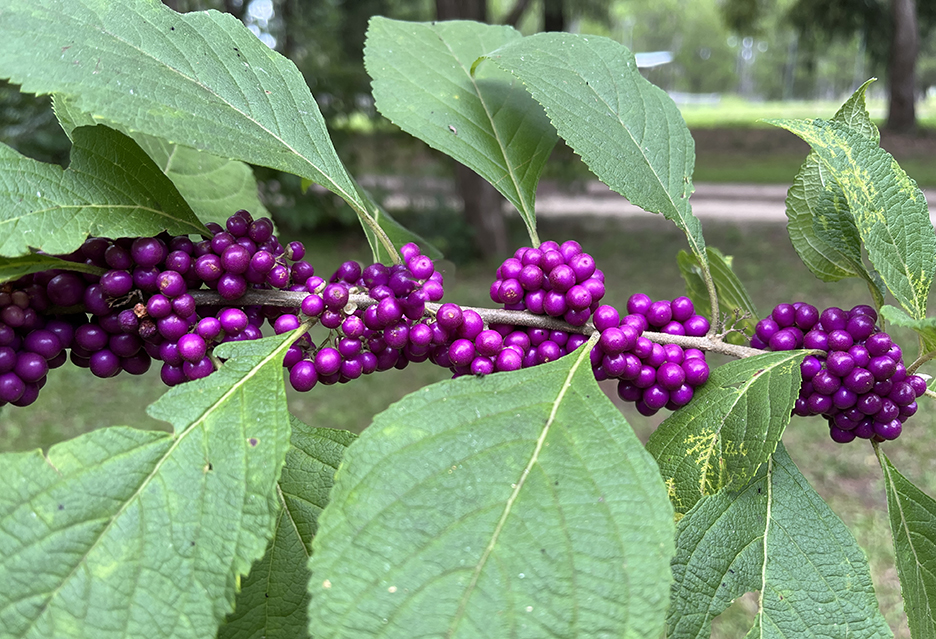When beautyberries start producing their eye-catching, bright purple fruit, we start to get lots of questions. People want to know what it is, where can they find it, and can they eat it? While the berries look good enough to eat, it’s best to leave them to the birds and deer. They are not toxic and were used by Native Americans for a root tea to treat fevers, stomach aches, malaria, and more, but the taste has been described as bitter and mealy. Many folks swear by beautyberry jelly, although I cannot say I’ve tried it. A little (or a lot) of sugar can make most anything taste good— and from photos of others’ handiwork, the finished product is a beautiful, translucent shade of fuchsia.
Even more interesting to me was the revelation that researchers have been able to extract compounds from beautyberry that successfully repel pest insects such as ticks and mosquitoes. The study began about 15 years ago, after a Mississippi botanist with the USDA Agricultural Research Service mentioned to a colleague that his grandfather taught him to rub the crushed leaves of beautyberry on his skin. The technique had been used as a home remedy to prevent mosquito bites for people (and horses) for generations. As a follow up experiment, another group of researchers found these same compounds—callicarpenal and intermedeol—successfully repelled black-legged ticks (which transmit Lyme disease) as effectively as DEET. In the last few years, researchers out of Mississippi have worked towards creating natural insect repellents from the compound that are less harsh on human skin that many commercially available brands.
Aside from its many practical uses, Callicarpa americana is a beautiful native shrub. It has wide green leaves and the brilliant purple berries grow in clusters along its stem. They stay on through late fall and winter in some places, making a beautiful contrast to fall foliage. Beautyberry shrubs can be found in a wide variety of habitats, including sandy and wet soils, full sun, and part shade. Their adaptability makes them a great plant for tight conditions like roadsides or yard edges, but also for nearly any home landscape. The plants can grow to a height of 4-8 feet and spread 3-6 feet wide. The long-lasting berries make them a great wildlife food source later in the cool season than many berry-producing species.
Information courtesy Carrie Stevenson, UF/IFAS Escambia County Extension office. https://sfyl.ifas.ufl.edu/escambia/
Linda Crum’s Beautyberry Jelly:
- Harvest and clean 8 cups of beauty berries
- Place berries in a large pot on stove
- Add 4 cups water and boil for 20 minutes. Allow to cool
- Place a cheesecloth-covered sieve over a bowl. Pour the boiled berries through the cheesecloth; mash to get 3 cups juice; add water to make 3 cups, if necessary. Discard any particles that don’t go through cheesecloth.
- Pour the juice through another sieve with a cheesecloth into a large pot.
- Add 1 package Sure Jell pectin in yellow box (do not use liquid Certo) and ½ pat butter. Bring to a rolling boil.
- Stir in 4 ½ cups sugar and bring to a boil for 2 minutes. Skim off foam.
- Pour into 6 half-pint jars.
- Process the jars in boiling water for 5 minutes to sterilize and preserve.
It is a tedious process to wash and clean the berries so if you cannot complete the whole process in one day, after you put juice through second sieve with cheese cloth, put the pot in the refrigerator and finish the processing the next day.
Important: use a large pot to cook the berries. Do not double the recipe unless your pot is deep and large. You will have a mess on the stove.
Recipe courtesy Linda Crum, Montgomery County Texas Master Gardener. https://mcmga.com/american-beautyberry-jelly-recipe/

